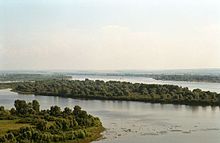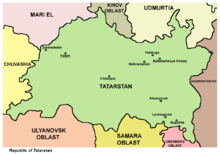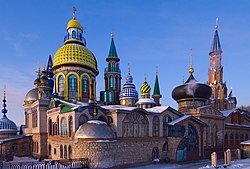The Republic of Tatarstan (Russian: Респу́блика Татарста́н, Respublika Tatarstan; Tatar Cyrillic: Татарстан Республикасы, Latin: Tatarstan Respublikası) is a federal subject of Russia (a republic) located in the Volga Federal District. Its capital Kazan is one of Russia's largest and most prosperous cities. Tatarstan shares borders with Kirov, Ulyanovsk, Samara, and Orenburg Oblasts, and with the Mari El, Udmurt, Chuvash Republics, and the Republic of Bashkortostan. The unofficial Tatarstan motto is: Bez Buldırabız! (We can!).[14]
Contents[hide] |
[edit] Terminology
"Tatarstan" derives from the name of the Tatar ethnic group and the Persian suffix -stan (an ending common to many Central Asian countries). Another version of the Russian name is "Тата́рия" (Tatariya), which was official along with "Tatar ASSR" during the Soviet rule.
The people of ethnic majority of Tatarstan are usually offended when called Tartars. The preferred name is Tatars. Inhabitants of Tatarstan regardless of ethnicity are usually called Tatarstaners (Tatar Cyrillic: татарстанлы, Latin: Tatarstanlı, татарстанцы).
Some Tatarstaners wish for their state to be renamed Bulgaristan or Bulgaria (like Alania), claiming that:
- Volga Bulgaria was the earliest known organized state within the boundaries of Tatarstan.
- The region was called Bulgaristan by its inhabitants until 1922 in tribute to the early settlers.
- Tatars should be named Bulgars (Volga Bulgars) due to some historical realities.
[edit] History
| This section needs additional citations for verification. Please help improve this article by adding reliable references. Unsourced material may be challenged and removed. (February 2011) |
[edit] Middle Ages
| History of Tatarstan | |
|---|---|
 This article is part of a series | |
| Great Bulgaria | |
| Khazars | |
| Volga Bulgaria | |
| Kipchaks | |
| Mongol invasion | |
| Golden Horde | |
| Khanate of Kazan | |
| Muscovy | |
| Kazan Governorate | |
| Idel-Ural State | |
| Tatar ASSR | |
| Republic of Tatarstan | |
| Tatarstan Portal |
The earliest known organized state within the boundaries of Tatarstan was Volga Bulgaria (c. 700–1238 CE). The Volga Bulgars had an advanced mercantile state with trade contacts throughout Inner Eurasia, the Middle East and the Baltic, which maintained its independence despite pressure by such nations as the Khazars, the Kievan Rus and the Cuman-Kipchaks. Islam was introduced by missionaries from Baghdad around the time of ibn Fadlan's journey in 922.
Volga Bulgaria finally fell to the armies of the Mongol prince Batu Khan in the late 1230s (see Mongol invasion of Volga Bulgaria.) The inhabitants, mixing with the Golden Horde's Turco-Mongolian, Kipchak-speaking troops and settlers, became known as the "Volga Tatars." Another theory postulates that there were no ethnic changes in that period, and Bulgars simply switched to the Kipchak-based Tatar language. In the 1430s, the region again became independent as the base of the Khanate of Kazan, a capital having been established in Kazan, 170 km up the Volga from the ruined capital of the Bulgars.
The Khanate of Kazan was conquered by the troops of Tsar Ivan IV the Terrible in the 1550s, with Kazan being taken in 1552. Some Tatars were forcibly converted to Christianity and cathedrals were built in Kazan; by 1593 all mosques in the area were destroyed. The Russian government forbade the construction of mosques, a prohibition that was not lifted until the 18th century by Catherine II. The first mosque to be rebuilt under Catherine's auspices was constructed in 1766-1770.
[edit] Modern times
In the 19th century Tatarstan became a center of Jadidism, an Islamic movement that preached tolerance of other religions. Under the influence of local Jadidist theologians, the Tatars were renowned for their friendly relations with other peoples of the Russian Empire. However, after the October Revolution religion was largely outlawed and all theologians were repressed.
During the Civil War of 1918-1920 Tatar nationalists attempted to establish an independent republic (the Idel-Ural State). They were, however, put down by the Bolsheviks and the Tatar Autonomous Soviet Socialist Republic was established on 27 May 1920. There was a famine in the Tatar Autonomous Soviet Socialist Republic in 1921 to 1922 as a result of war communist policy. The boundaries of the republic did not include majority of the Volga Tatars. The Tatar Union of the Godless were murdered in the 1928 purges.
[edit] Tatarstan today
On 30 August 1990, Tatarstan announced its sovereignty with Declaration on the State Sovereignty of the Tatar Soviet Socialist Republic[15] and in 1992 Tatarstan held a referendum on the new constitution,[16] and 62 percent of those who took part voted in favor of the constitution. Articles 1 and 3 of the constitution, as introduced in 2002[16] define Tatarstan as a part of Russian Federation.
On 15 February 1994, the Treaty On Delimitation of Jurisdictional Subjects and Mutual Delegation of Authority between the State Bodies of the Russian Federation and the State Bodies of the Republic of Tatarstan[17] and Agreement between the Government of the Russian Federation and the Government of the Republic of Tatarstan (On Delimitation of Authority in the Sphere of Foreign Economic Relations) were signed.
[edit] Demographics
| Births | Deaths | Birth rate | Death rate | |
|---|---|---|---|---|
| 1970 | 47,817 | 25,622 | 15.2 | 8.1 |
| 1975 | 55,095 | 29,686 | 16.6 | 9.0 |
| 1980 | 54,272 | 32,758 | 15.7 | 9.5 |
| 1985 | 64,067 | 34,622 | 18.1 | 9.8 |
| 1990 | 56,277 | 36,219 | 15.4 | 9.9 |
| 1991 | 50,160 | 37,266 | 13.6 | 10.1 |
| 1992 | 44,990 | 39,148 | 12.1 | 10.6 |
| 1993 | 41,144 | 44,291 | 11.0 | 11.9 |
| 1994 | 41,811 | 48,613 | 11.2 | 13.0 |
| 1995 | 39,070 | 48,592 | 10.4 | 12.9 |
| 1996 | 38,080 | 45,731 | 10.1 | 12.1 |
| 1997 | 37,268 | 46,270 | 9.9 | 12.3 |
| 1998 | 37,182 | 45,153 | 9.8 | 11.9 |
| 1999 | 35,073 | 46,679 | 9.3 | 12.3 |
| 2000 | 35,446 | 49,723 | 9.4 | 13.1 |
| 2001 | 35,877 | 50,119 | 9.5 | 13.2 |
| 2002 | 38,178 | 51,685 | 10.1 | 13.7 |
| 2003 | 38,461 | 52,263 | 10.2 | 13.8 |
| 2004 | 38,661 | 51,322 | 10.3 | 13.6 |
| 2005 | 36,967 | 51,841 | 9.8 | 13.8 |
| 2006 | 37,303 | 49,218 | 9.9 | 13.1 |
| 2007 | 40,892 | 48,962 | 10.9 | 13.0 |
| 2008 | 44,290 | 48,952 | 11.8 | 13.0 |
| 2009 | 46,605 | 47,892 | 12.4 | 12.7 |
| 2010 | 48,935 | 49,907 | 12.9 | 13.4 |
[edit] Ethnic groups
There are about two million ethnic Tatars and a million and a half ethnic Russians, along with significant numbers of Chuvash, Mari, and Udmurts, many of whom are Tatar-speaking. The Ukrainian, Mordvin, and Bashkir minorities are also significant. Most Tatars are Sunni Muslims, but a small minority known as Keräşen Tatars are Orthodox and some of them regard themselves as being different from other Tatars even though most Keräşen dialects differ only slightly from the Central Dialect of the Tatar language.[18] There is a fair degree of speculation as to the early origins of the different groups of Tatars, but most Tatars no longer view religious identity as being as important as it once was, and the religious and linguistic subgroups have intermingled considerably. Nevertheless, despite many decades of assimilation and intermingling, some Keräşen demanded, and were awarded, the option of being specifically enumerated in 2002. This has provoked great controversy however, as many intellectuals have sought to portray the Tatars as homogenous and indivisible.[19] Although listed separately below, the Keräşen are still included in the grand total for the Tatars. Another unique ethnic group, living in Tatarstan only are the Qaratay Mordvins.
The official languages are Tatar and Russian. According to the 2002 Russian Federal Law (On Languages of Peoples of the Russian Federation), the official script is Cyrillic.
[edit] Geography
The republic is located in the center of the East European Plain, approximately 800 kilometers (497 mi) east of Moscow. It lies between the Volga River and the Kama River (a tributary of the Volga), and extends east to the Ural mountains.
- Borders:
- internal: Kirov Oblast (N), Udmurt Republic (N/NE), Republic of Bashkortostan (E/SE), Orenburg Oblast (SE), Samara Oblast (S), Ulyanovsk Oblast (S/SW), Chuvash Republic (W), Mari El Republic (W/NW).
- Highest point: 343 m (1,125 ft)[citation needed]
- Maximum N->S distance: 290 km (180 mi)
- Maximum E->W distance: 460 km (290 mi)
[edit] Rivers
Major rivers include (Tatar names are given in parentheses):
[edit] Lakes
Major reservoirs of the republic include (Tatar names are given in parentheses):
The biggest lake is Qaban. The biggest swamp is Kulyagash.
[edit] Hills
[edit] Natural resources


Major natural resources of Tatarstan include oil, natural gas, gypsum, and more. It is estimated that the Republic has over one billion tons of oil deposits.[20]
[edit] Climate
- Average January temperature: −16 °C (3.2 °F)
- Average July temperature: 19 °C (66.2 °F)
- Average annual precipitation: up to 500 mm (20 in)
[edit] Administrative divisions
[edit] Politics
| | This section does not cite any references or sources. Please help improve this section by adding citations to reliable sources. Unsourced material may be challenged and removed. (February 2011) |
The head of the government in Tatarstan is the President. As of 2011, the President is Rustam Minnikhanov. Tatarstan's unicameral State Council has 100 seats: fifty are for representatives of the parties, other fifty are for deputies from the republic's localities. The Chairman of the State Council is Farit Mukhametshin from May 27, 1998.
According to the Constitution of the Republic of Tatarstan, the President can be elected only by the people of Tatarstan, but due to Russian federal law this law was suspended for an indefinite term. The Russian law about election of governors says they should be elected by local parliaments and that the candidate can be presented only by the president.
On March 25, 2005 Shaymiyev was re-elected for his fourth term by the State Council. This election was held after changes in electoral law and does not contradict the Constitutions of Tatarstan and Russia.
[edit] Political status
The Republic of Tatarstan is a constituent republic of the Russian Federation. Most of the Russian federal subjects are tied with the Russian federal government by the uniform Federal Treaty, but relations between the government of Tatarstan and the Russian federal government are more complex, and are precisely defined in the Constitution. The following passage from the Constitution defines the republic's status without contradicting the Constitution of the Russian Federation:
The Republic of Tatarstan is a democratic constitutional State associated with the Russian Federation by the Constitution of the Russian Federation, the Constitution of the Republic of Tatarstan and the Treaty between the Russian Federation and the Republic of Tatarstan On Delimitation of Jurisdictional Subjects and Mutual Delegation of Powers between the State Bodies of the Russian Federation and the State Bodies of the Republic of Tatarstan, and a subject of the Russian Federation. The sovereignty of the Republic of Tatarstan shall consist in full possession of the State authority (legislative, executive and judicial) beyond the competence of the Russian Federation and powers of the Russian Federation in the sphere of shared competence of the Russian Federation and the Republic of Tatarstan and shall be an inalienable qualitative status of the Republic of Tatarstan.[cite this quote]
[edit] Economy
Tatarstan is one of the most economically developed regions of Russia. The republic is highly industrialized, and ranks second only to Samara Oblast in terms of industrial production per km2.[21] Tatarstan's GDP per capita was USD 12,325 in 2004,[22] with GDP in 2008 at about 930 billion rubles.[20]
The region's main source of wealth is oil. Tatarstan produces 32 million tonnes of crude oil per year and has estimated oil reserves of more than 1 billion tons.[20][23] Industrial production constitutes 45% of the Republic's gross regional domestic product. The most developed manufacturing industries are petrochemical industry and machine building. The truck-maker KamAZ is the region's largest enterprise and employs about 1/5 of Tatarstan's work force.[23] Kazanorgsintez, based in Kazan, is one of Russia's largest chemical companies.[24] Tatarstan's aviation industry produces Tu-214 passenger airplanes and helicopters.[20] The Kazan Helicopter Plant is one of the largest helicopter manufacturers in the world.[25] Engineering, textiles, clothing, wood processing, and food industries are also of key significance in Tatarstan.[21]
Tatarstan consists of three distinguished industrial regions. The northwestern part is an old industrial region where engineering, chemical and light industry dominate. In the new industrial Northeast region with its core in the Naberezhnye Chelny-Nizhnekamsk agglomeration, major industries are automobile construction, chemical industry, and power engineering. The Southeast region has oil production with engineering under development. The North, Central, South, and Southwest parts of the Republic are rural regions.[26]
The Republic has a highly developed transport network. It mainly comprises highways, railway lines, four navigable rivers — Volga (İdel), Kama (Çulman), Vyatka (Noqrat) and Belaya (Ağidel), and oil pipelines and airlines. The territory of Tatarstan is crossed by the main gas pipelines carrying natural gas from Urengoy and Yamburg to the west and the major oil pipelines supplying oil to various cities in the European part of Russia.
[edit] Culture
Major libraries include the Science Library of Kazan State University and the National Library of the Republic of Tatarstan. There are two museums of republican significance, as well as 90 museums of local importance. In the past several years new museums appeared throughout the Republic.
There are twelve theatrical institutions in Tatarstan.[27] The state orchestra is the National Tatarstan Orchestra.
[edit] Education
The most important facilities of higher education include Kazan State University, Kazan State Medical University, Kazan State Technological University, World Information Distributed University, Kazan State Technical University, Kazan State Finance and Economics Institute and Russian Islam University, all located in the capital Kazan.
[edit] Religion


Established in 922, the first Muslim state in Russia was Volga Bulgaria from which the Tatars inherited Islam. Islam was introduced by missionaries[28] from Baghdad around the time of Ibn Fadlan's journey in 922. Islam's long presence in Russia also extends at least as far back as the conquest of the Khanate of Kazan in 1552, which brought the Tatars and Bashkirs on the Middle Volga into Russia.
In the 1430s, the region became independent as the base of the Khanate of Kazan, a capital having been established in Kazan, 170 km up the Volga from the ruined capital of the Bulgars. The Khanate of Kazan was conquered by the troops of Tsar Ivan IV the Terrible in the 1550s, with Kazan being taken in 1552. Some Tatars were forcibly converted to Christianity and cathedrals were built in Kazan; by 1593, mosques in the area were destroyed. The Russian government forbade the construction of mosques, a prohibition that was not lifted until the 18th century by Catherine II.
In 1990, there were only 100 mosques but the number, as of 2004, rose to well over 1,000. As of January 1, 2008, as many as 1,398 religious organizations were registered in Tatarstan, of which 1,055 were Muslim. Today, Sunni Islam is the most common faith in Tatarstan, as 52% of the estimated 3.8 million population is Muslim.[29] In September 2010, Eid al fitr as well May 21, the day the Volga Bulgars embraced Islam, were made public holidays.[30] Tatarstan also hosted an international Muslim film festival which screened over 70 films from 28 countries including Jordan, Afghanistan and Egypt.[31]
The Russian Orthodox Church is the second largest active religion in Tatarstan for more than 150 years[32] with an estimated 1.6 million followers made up of Ethnic Russians, Mordvins, Armenians, Belarusians, Mari people, Georgians, Chuvash and a number of Orthodox Tatars which together comprise of 46% of the 3.8 million population of Tatarstan. On the 23rd of August 2010 the “Orthodox monuments of Tatarstan” exhibition was held in Kazan by the Tatarstan Ministry of Culture and the Kazan Eparchy.[33] At all public events an Orthodox Priest is called upon along with an Islamic Mufti.[3-copy of wikipedia










No comments:
Post a Comment